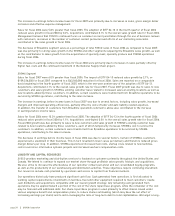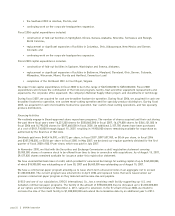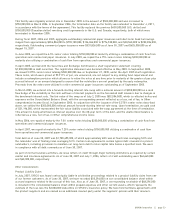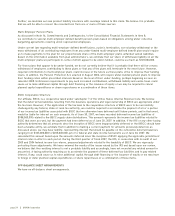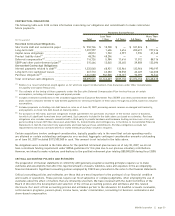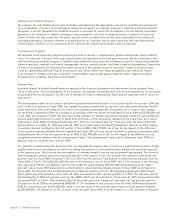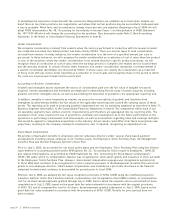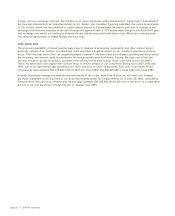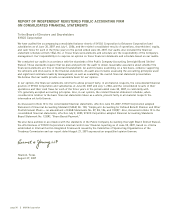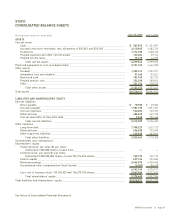Sysco 2007 Annual Report Download - page 55
Download and view the complete annual report
Please find page 55 of the 2007 Sysco annual report below. You can navigate through the pages in the report by either clicking on the pages listed below, or by using the keyword search tool below to find specific information within the annual report.As a result of adopting SFAS 123(R) on July 3, 2005, SYSCO’s earnings before income taxes and net earnings for fiscal
2006 were $118,038,000 and $105,810,000 lower, respectively, than if the company had continued to account for share-
based compensation under APB 25. Basic and diluted earnings per share before the cumulative effect of the accounting
change for fiscal 2006 were both $0.17 lower than if the company had continued to account for share-based compensation
under APB 25.
As of June 30, 2007, there was $82,175,000 of total unrecognized compensation cost related to share-based compensation
arrangements. That cost is expected to be recognized over a weighted-average period of 2.68 years.
The fair value of each option award is estimated on the date of grant using a Black-Scholes option pricing model.
Expected volatility is based on historical volatility of SYSCO’s stock, implied volatilities from traded options on SYSCO’s
stock and other factors. We utilize historical data to estimate option exercise and employee termination behavior
within the valuation model; separate groups of employees that have similar historical exercise behavior are considered
separately for valuation purposes. The risk-free rate for the expected term of the option is based on the U.S. Treasury
yield curve in effect at the time of grant.
The fair value of the stock issued under the Employee Stock Purchase Plan is calculated as the difference between the
stock price and the employee purchase price. The fair value of the stock issued under the Management Incentive Plans
is based on the stock price less a 12% discount for post-vesting restrictions. The discount for post-vesting restrictions
is estimated based on restricted stock studies and by calculating the cost of a hypothetical protective put option over
the restriction period.
The compensation cost related to these share-based awards is recognized over the requisite service period. The requisite
service period is generally the period during which an employee is required to provide service in exchange for the award.
The compensation cost related to stock issuances resulting from awards under the Management Incentive Plan is accrued
over the fiscal year to which the incentive bonus relates. The compensation cost related to stock issuances resulting from
employee purchases of stock under the Employees’ Stock Purchase Plan is recognized during the quarter in which the
employee payroll withholdings are made.
Certain of our option awards are generally subject to graded vesting over a service period. In those cases, we will
recognize compensation cost on a straight-line basis over the requisite service period for the entire award. In other cases,
certain of our option awards provide for graded vesting over a service period but include a performance-based provision
allowing for the vesting to accelerate. In these cases, if it is probable that the performance condition will be met,
we recognize compensation cost on a straight-line basis over the shorter performance period; otherwise, we recognize
compensation cost over the probable longer service period.
In addition, certain of our options provide that if the optionee retires at certain age and years of service thresholds,
the options continue to vest as if the optionee continued to be an employee. In these cases, for awards granted prior to
July 2, 2005, we will recognize the compensation cost for such awards over the remaining service period and accelerate
any remaining unrecognized compensation cost when the employee retires. For awards granted subsequent to
July 3, 2005, we will recognize compensation cost for such awards over the period from the date of grant to the date
the employee first becomes eligible to retire with his options continuing to vest after retirement.
Our option grants include options that qualify as incentive stock options for income tax purposes. In the period the
compensation cost related to incentive stock options is recorded, a corresponding tax benefit is not recorded as it is
assumed that we will not receive a tax deduction related to such incentive stock options. We may be eligible for tax
deductions in subsequent periods to the extent that there is a disqualifying disposition of the incentive stock option.
In such cases, we would record a tax benefit related to the tax deduction in an amount not to exceed the corresponding
cumulative compensation cost recorded in the financial statements on the particular options multiplied by the statutory
tax rate.
NEW ACCOUNTING STANDARDS
In June 2006, the FASB issued FASB Interpretation No. 48, “Accounting for Uncertainty in Income Taxes — an
Interpretation of FASB Statement No. 109” (FIN 48), which clarifies the accounting for uncertainty in income taxes
recognized in accordance with FASB Statement No. 109 (SFAS 109). FIN 48 clarifies the application of SFAS 109 by
defining criteria that an individual tax position must meet for any part of the benefit of that position to be recognized in
SYSCO Corporation ][ page 29



